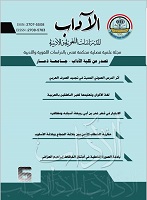Al-Ddūrrah Al-Yatīmah "The Orphaned Pearl" by [Dawglah Al-Manbajī (C. 2 AH)], explained by IbnMusafir Al- Shami al-ƆAmawiCumaribn al-HasanibnCodai (C. 7 AH): Editing of the Ascribing and Revising the Text
DOI:
https://doi.org/10.53286/arts.v1i6.267Keywords:
Al-Ddūrrah Al-Yatīmah , Ibn Musafir, a rare .explanation, Dawglah Al-ManbajīAbstract
This study deals with a famous poem, however, the scholars did not agree on the validity of its affiliation to a specific poet, rather; The research included the revising of a single explanation of this orphan poem, published for the first time, by Ibn Musafir, Al-Shami Al-Umawi, one of the famous figures of the seventh century AH.The study divides into two parts, the first deals with the editing of the poem ascribing, starting with a preface followed by documentation, and a biography of the writer who has been known as a result of this research, followed by another biography of the owner of the poem explanation, then this section was concluded with a glossary of the most important previous studies of the poem arranged according to its publication year.The second section, it revised the explanation of the poem. It was sought to revise the text as close as possible to what its owner wanted, with displays of contradictions, and corrections and misrepresentations as possible. The research resulted in the ascribing likelihood of the poem to Dawglah Al-Manbiji, as it removed a problematic and deconstructed a conflict and presented a verified straight text, in addition to gaining of the poem a precious explanation, so it and its explanation become in the hands of researchers, rich materials added to the heritage texts that our ancestors left for us.Downloads
Downloads
Published
How to Cite
Issue
Section
License
Copyright (c) 2021 مقبل التّامّ عامر الأحمديّ

This work is licensed under a Creative Commons Attribution 4.0 International License.
Copyright and Licensing
copyright is retained by the authors. Articles are licensed under an open access Creative Commons CC BY 4.0 license, meaning that anyone may download and read the paper for free. In addition, the article may be reused and quoted provided that the original published version is cited. These conditions allow for maximum use and exposure of the work.



